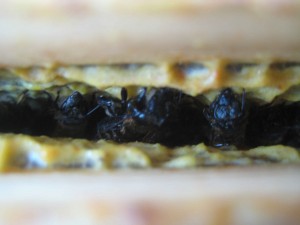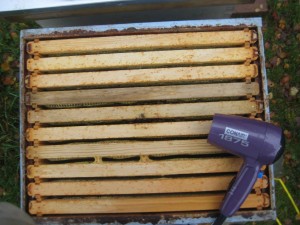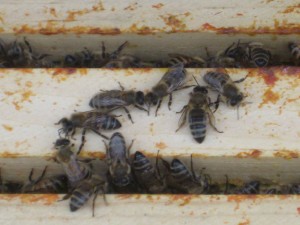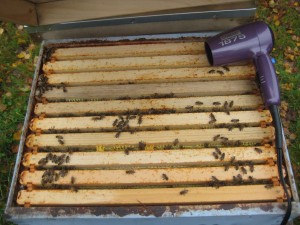We don’t actually call them hurricanes in Washington, but winds last Tuesday night were in the 90 mile-per-hour range. In addition to knocking down one of our hemlock trees, the winds blew the cover off hive nine.
I keep bricks on top of my hives to hold the covers on in our high winds.  Unfortunately, hive nine only had a small brick and a chunk of 2×6. When I did an inspection of my hives Wednesday morning, I found both the outer and inner covers had blown off, and all the worker bees clumped in the top box were soaked. Their fur, wings and antennae were matted down, their bodies slick with water. In a word, they looked dead; but I could hear buzzing coming from the lower box.
Unfortunately, hive nine only had a small brick and a chunk of 2×6. When I did an inspection of my hives Wednesday morning, I found both the outer and inner covers had blown off, and all the worker bees clumped in the top box were soaked. Their fur, wings and antennae were matted down, their bodies slick with water. In a word, they looked dead; but I could hear buzzing coming from the lower box.
The rain was pouring down so I quickly replaced the outer cover and started stringing up extension cords from the barn to the apiary. I had a crazy idea, one that couldn’t hurt to try…
For the next hour I stood over the colony with an umbrella in one hand and a hair-dryer in the other. Slowly, as they warmed, workers started making their way to the top of the frames. As they dried, their fur fluffed back out and their wings firmed back out. Antennae waved at me and the drier.
Once the first newly-dried girls started flying around I simply left the hair-dryer propped under the outer cover, moving it to a new location every hour.
After 4-1/2 hours I could not see any more soaked bees between the frames, and lots of worker bees were crawling around the tops of the frames. I replaced the inner and outer lids and remain hopeful that hive nine will survive the winter.
Despite the cold and the wind and the rain, the workers in hive nine stuck to their posts, intent on protecting their queen and the hive. I’m grateful to get to share my life with such resilient animals.



{ 3 comments }
I read, again and again, that people iretntseing in beginning with beekeeping believe that top-bar beekeeping is “more natural.”Why was I not paying attention to the part where anyone explained why one style of hive is more or less natural? I’ve read a lot about beekeeping, and keep bees myself, but I’ve yet to hear what the “natural” argument actually is.I;m not trying to be antagonistic. It has just become a sort of article of faith among a certain class of garden blogger that top bar hives are a more natural home for the european honeybee.(For what it’s worth, we utilize a foundationless form of the Langstroth hive. It works well for the bees in our hives.)
Wow, that’s dedication! How are they doing now?
I keep bees with Langstroth hives. If I had the chance to host I would delteiinfy have gone that route as a new beekeeper, especially since you get *some* honey out of the deal. One of the major reasons I want the bees is for pollination services, and I would get that whether they were my bees or not. The costs for beekeeping are steep, so why not host for a year and see if you really want to have them around and bear the expense yourself. Even if you decide to go with top bar hives, hosting for a year would be a great learning experience for you and your family.